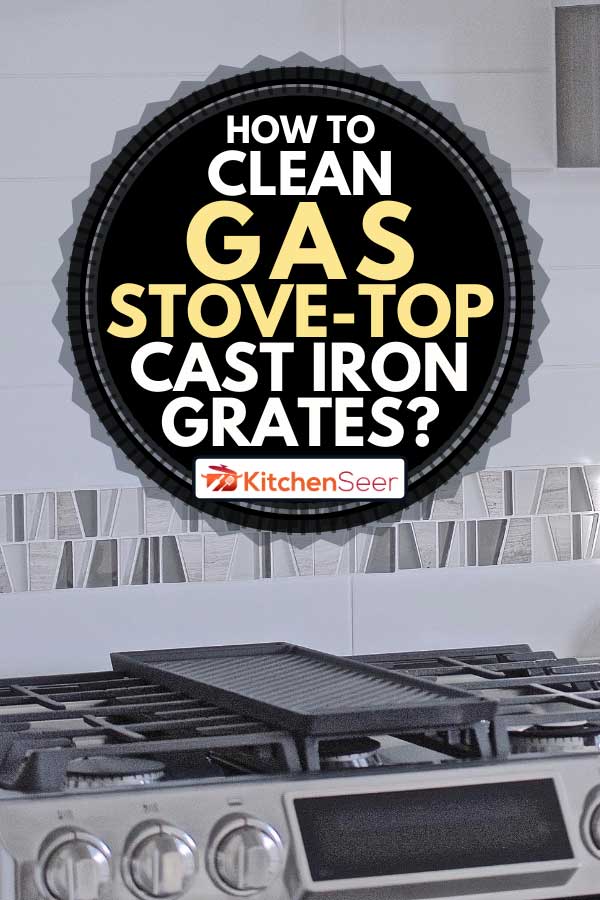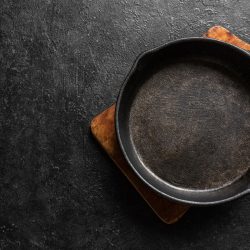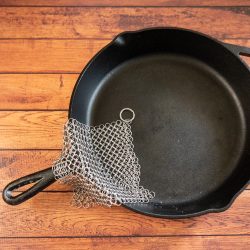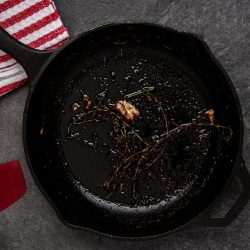When you’re in the kitchen after cooking dinner and need to know how to clean your cast iron stovetop - you’ve come to the right place! We have researched all the best ways for you. Before we share our tips and tricks, keep in mind that safety is always a must when working with cast iron.
To clean your gas stove-top cast-iron grates:
- Remove any pots or pans from the stovetop.
- Set burners on high heat to help remove excess food.
- Turn off after seeing a little smoke, or a few moments have passed.
- Take grates off the stovetop after they’ve cooled, but are still warm to the touch.
- Grates should soak in a sink of hot water for an hour or two.
- Use a cast-iron brush to scrub gently and a lint-free cloth to dry.
Does it sound more straightforward than you assumed cleaning cast-iron to be? A pleasant surprise, right? That is why the following information will provide you with a detailed how-to for performing these steps, and some lesser-known, equally effective techniques. These unique methods surprised us; they may do the same for you!

Each Approach Must Begin With Safety
While working in any kitchen, always keep in mind the safety of everyone present, the home or building you’re in, and the appliance at hand. Any utensils removed from the stove before heating the grates should be put far away from heat. Be aware of your surroundings.
Set Burners on High Heat to Help Remove Excess Food
Burning off excess crumbs on and around your stovetop grates makes scrubbing easier, but it requires paying attention to the stove for the whole time heat is on.
If you are multitasking or have children nearby, it is acceptable to skip this step. No worries, we have a secret up our sleeve that can substitute.
Let the Surface Cool
We understand it can be tough to determine when they have cooled enough, and the less time spent cleaning, the better. Goldilocks may have had time to dillydally, but we live in a busy world. A non-contact digital thermometer is a fast and precise way of checking your stovetop’s temperature.
Soaking The Cast Iron Grates
After cooling, fill your sink with hot water to let them soak. No standard soap or detergent allowed! It can remove the metal’s coating, unfortunately. The best temperature for water would be close to the same as the grates or a little warmer. Ideal soaking time is only 1-2 hours; no longer. It will ensure the longevity of your cast iron. The digital thermometer would be helpful here too!
Time and Temperature Specifics
Water that is too cold might make residue more challenging to remove, or even slightly warp the frame. If water is overly hot, the thin layer of oil baked onto the surface could come off and cause rusting. Lastly, leaving them to soak overnight may cause even more damage by rust.
Iron is Strong, but Rust Finds A Way.
The safety of preventing rust or iron oxide on any cast-iron appliances is critical. Using rusted grates on your stove is believed to be even more dangerous than consuming small amounts from a rusted skillet. Our readers’ health and well-being are a priority, so we dug deep while researching this.
Specifically, two sources were informative above the rest. This FDA regulation and CDC and OSHA document show that iron oxide is authorized as an additive in supplements or vitamins if it is under 5mg. Meanwhile, the dust caused by dry rust when heated can cause serious health complications in the lungs.
At first glance, rusted cast-iron may not be easily visible. Check once every two months on your grates’ undersides to look for any signs of rust forming.
Brush, Rinse, and Dry.
While scrubbing, a cast-iron brush is far easier on the metal than wire pads or any steel wool. After washing, give a short rinse with water. Dry with a lint-free cloth afterward. A clean bandana works well; things like paper towels or terry cloth commonly leave behind chunks of fabric that are hard to remove.
There you have it!
Reattach your cast-iron stovetop grates, fitting them correctly as before, and you are all set! Cast-iron utensils that regularly come into direct contact with the food you eat need washing after each use, but the stovetop grates only need it when food residue builds up, or there is a spill.
Alternates and Substitutes for High Heat
Is using heat to burn off the excess, and make removal easier off the table? That’s okay! Two everyday household items have been useful in the process of cleaning cast-iron stovetop grates. Ironically enough, they are used more in food preparation rather than as cleaning agents; vinegar and baking soda. Here’s the rundown -
How to Clean Cast-Iron with Vinegar
We consume this sour food additive often in pickles, hot sauces, ketchup, balsamic dressing, broth-based soups, and a lengthy list of different alcohol types. Since it is an acidic liquid, it is excellent at cleaning or removing rust too!
Using acidic materials to clean cast-iron must be used in mindful amounts because after it lifts the rust, it can begin going through original coatings on the grates. However, much vinegar you plan on using, combine it with an equal amount of water added to the soaking sink or container to help prevent this.
How to Clean Cast-Iron with Baking Soda
Baking soda is a substance used in cooking and cleaning, also known as sodium bicarbonate, an antacid for heartburn! According to this article from The National Library of Medicine, baking soda would be beneficial to apply a dust coating before soaking and scrubbing. The main benefit is due to the component being antibacterial. Hopefully, this relieves any nervousness in those who cringed at the idea of not using any soap!
Should You Season Cast Iron Stove Grates?
Yes, and the process is simple. Most of these grates get seasoned during production, but if owners add layers, the iron will be much more protected. After drying, dab vegetable or canola oil onto another clean bandana, and wipe down all metal areas.
How To Make Cast-Iron Look Brand New Again?
Each option above should have your stovetop looking tip-top by the time you finish, but in case you aren’t satisfied with the results, there is an opportunity to go the extra mile. Made by the company, Caron & Doucet, There is a three-product kit available that has fantastic reviews. The kit includes a specially formulated plant-based soap and oil created to restore your cast-iron products to their glory days.
Click here to see this on Amazon.
Now that you know the ins-and-outs, best of luck to you and your stovetop! Anything made from cast-iron can cost a pretty penny but will last for decades. If you regularly clean those appliances, your wallet, and your future self sure will appreciate it!








